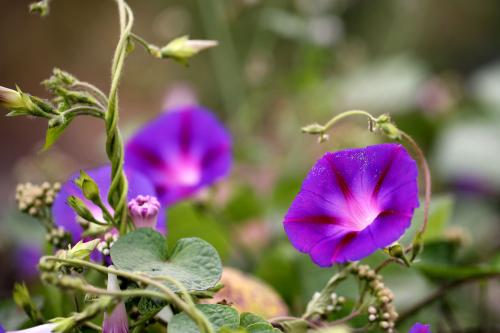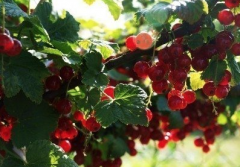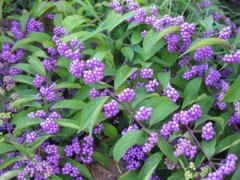The introduction of morning glory, how to control the number of morning glory, how to eliminate morning glory weeds
Morning glory weeds in the garden can be seen as a nemesis because of their ability to quickly spread and take over the garden area. Or you can release this tension and Zen by enjoying twining vines and lovely soft flowers. Most gardeners want to know how to kill morning glory weeds, but if you have a 40-year-old or wild spare, morning glory vine is an excellent uncared for plant that will stick to and produce lovely spring and summer flower shows.
However, the control of morning glory weeds in the cultivated landscape is essential to prevent plant takeover. Morning glory and whirlwind morning glory belong to a unique and tenacious plant called Ipomoea. It is closely related to perennial whorl plants or spiral flowers. Morning glory vine is once a year, but if you replant it successfully, you really won't know about it. Spiral plants grow from rhizomes or underground storage structures to promote the spread of weeds. They are hard and stubborn opportunistic weeds that can enter cracks and cracks and are almost impossible to remove.
Many gardeners classify morning glory as a plant. Instead, their independent classification and growth patterns clearly classify the two as very different plants with similar flowers. Morning glory and rattan information another difference between morning glory and swirl is the availability of seeds each year and the inability to obtain whorl seeds. Who wants to plant a weed that can grow noticeably in a day, can spread on almost any surface, and won't die unless you use chemicals? Morning glory is more adaptable and has a wide range of seeds to choose from. Slender stems grow rapidly and wind around each other for support. The flowers are funnel-shaped, sometimes with deeper or lighter throats. The garden supply center is mainly pink, rose, purple, lavender and white. The morning glory vine is named after the habit of flowers that bloom in the first ray of morning light and the habit of flowers that close when the day is hot and the sun comes.
Morning glory weeds in the garden are ideal for natural decoration of ground coverings, fences and obstacles, as well as landscaping equipment for broken sheds or barns that have not been removed. Be careful when you plant this vine, as it grows at an incredible rate and can be very invasive and difficult to remove. Many gardeners are confused about how to kill morning glory and say morning glory is spinning. Although plants are independent species, they do have similar stubborn growth habits and are difficult to eradicate by pulling.
Morning glory weed control is a multi-part task. Pre-budding herbicides have no effect on the plant. Pulling is labor-intensive and tends to destroy the vine, which may even grow again. Getting rid of plants completely can be a maddening thing that takes a long time. Using thick mulch or weed isolation fabric can help stifle spring seedlings. Don't let the grapevines blossom and plant seeds, which will prevent some buds in the next spring. Glyphosate and some broad-leaf herbicides have some effect, but you need to spray them early in the young season. Any systemic selective herbicide is a better choice because glyphosate can also affect the plants around you. However,
It is widely available, and applying it to the leaves helps prevent drift and damage to the surrounding plants. No matter which method you use, you need to be vigilant and monitor and deal with new plants. It takes several seasons to control morning glory, and long-lasting seeds in the soil can germinate after many years. Morning glory can be an honor in the garden, but it can also be a royal pain, so think once or twice before you install these rampant colorful vines.

- Prev

What is currant? what nutrients do you have? How to plant currants and how to care for currant shrubs
Ornamental and practical, currants are an excellent choice for family gardens in the northern states. Rich in nutrients and low in fat, no wonder raisins are more popular than ever. Although they are usually used for baking, jams and jellies because they are sour, some types of sweetness
- Next

How to grow purple pearl grass? How do you cut down the grass every year?
Callicarpa americana shrubs (USDA regions 7 to 11) bloom in late summer, and although the flowers are not seen in abundance, the gem-like purple or white berries dazzle. Autumn leaves are charming yellow or yellowish green. These 3-to 8-foot bushes are at the border
Related
- A course of planting techniques and methods on how to grow carrots
- How to plant the latest tulips?
- Is it better to pick tea in the morning or in the afternoon? When is the best time for tea to be picked? what is the third or fifth tea?
- Launch Yuanxiao Happy combination Haocha + Tea Yuan healthy Taste
- Penghu Tourism "Fireworks 20 Parade with You"
- 2022 West Lake Happiness holds "Digital Revitalization Voucher" and draws iphone13 and laptop.
- Banqiao Fuzhou social houses are designed to change start-up combined with police elimination to create a safe and livable environment
- The convenient measure of "mechanical weeding" in Xinbei has been abused and the Agriculture Bureau has imposed heavy penalties on the illegal land consolidation.
- Changgeng University Joins Hands with Four Memory Factories to Rescue Memory Talent Shortage
- The list of Taiwan's top 100 MVP managers is listed by the Director-General of the Farmers' Association of Sanxia District.

